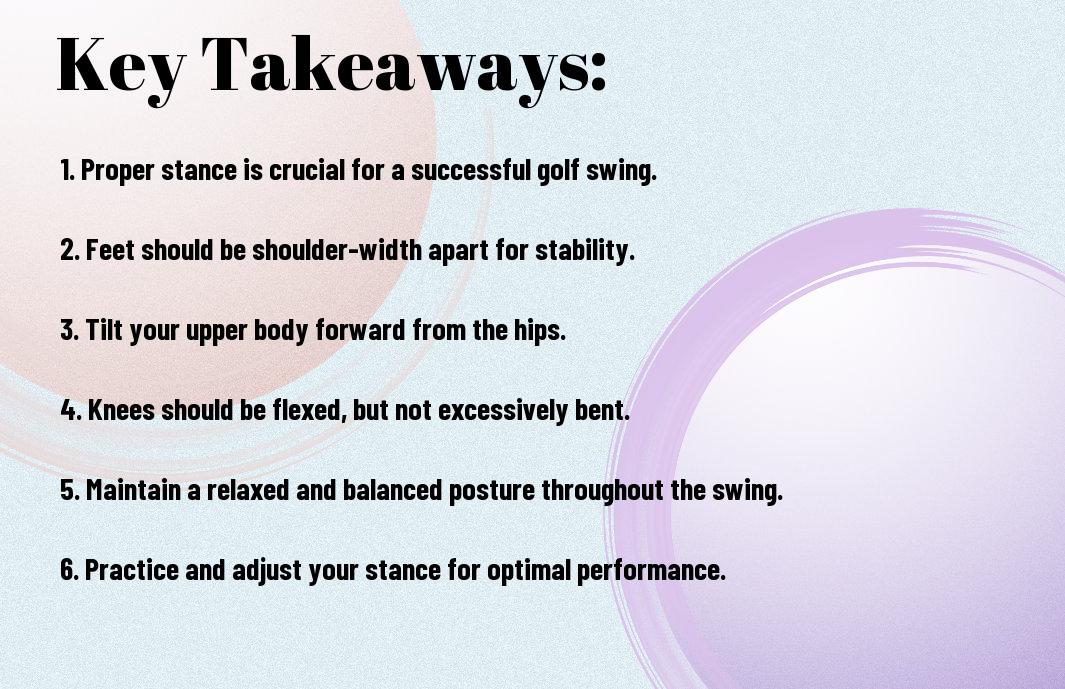Do you want to improve your golf swing and take your game to the next level? The ideal stance is the foundation of a successful golf swing, and mastering it is essential for consistent, powerful shots. In this step-by-step guide, you will learn how to achieve the perfect stance for maximum performance on the golf course.
Before delving into the details of the ideal stance, it’s important to understand the significance of this fundamental aspect of your golf game. Your stance not only impacts your balance and stability but also determines the alignment and trajectory of your shots. By the end of this guide, you will have a clear understanding of how to position your feet, body, and club for the perfect stance. For additional visual guidance, you can check out this comprehensive guide on How to Swing a Golf Club (with Pictures).
Key Takeaways:
- Proper alignment is essential: Ensuring that your body, feet, and club are aligned correctly can significantly impact the success of your swing. Take the time to position yourself properly before every swing.
- Maintain balance throughout the swing: Keeping a balanced stance when swinging is crucial for generating power and accuracy. Focus on distributing your weight evenly and avoid swaying or leaning too much during your swing.
- Practice consistency in stance and posture: Developing a consistent and repeatable stance and posture will lead to more consistent and accurate swings. Make it a priority to practice and fine-tune your stance and posture regularly.
The Anatomy of the Ideal Golf Swing
Some say that the key to a successful golf swing lies in understanding the anatomy of the ideal swing. Knowing the biomechanics and the role of timing and rhythm in your swing can improve your performance and help you achieve your best game yet. Let’s take a closer look at the essential components of the ideal golf swing.
Basic Biomechanics of Golf Swing
When it comes to the basic biomechanics of your golf swing, there are a few key points to keep in mind. Your stance, grip, and posture all play a crucial role in the execution of your swing. It’s important to ensure that your body is properly aligned and balanced to generate maximum power and accuracy in your shots. The rotation of your hips and shoulders also contributes to the force behind your swing, so focusing on the coordination of these movements is essential. Additionally, the sequence of movement from your backswing to your downswing impacts the overall efficiency and speed of your swing. Mastering these basic biomechanics can help you lay a solid foundation for your golf swing.
The Role of Timing and Rhythm in Golf Swing
One of the most crucial aspects of your golf swing is the timing and rhythm of your movements. Your ability to synchronize the movements of your body with the swing of the club can significantly impact the accuracy and power of your shot. Maintaining a consistent tempo and rhythm throughout your swing is key to achieving a smooth and controlled motion. Finding the right balance between generating power and maintaining control is crucial in achieving the perfect swing. Developing a solid sense of timing and rhythm in your swing can ultimately lead to more consistent and successful shots on the course.
Understanding Golf Stance
While it may seem simple at first glance, the golf stance is a crucial aspect of your swing that can greatly impact your overall performance on the course. A proper stance provides the foundation for a powerful and consistent swing, allowing you to generate maximum clubhead speed and accuracy. Understanding the key elements of a good golf stance is essential for achieving success in the game.
Importance of Proper Golf Stance
Your golf stance plays a critical role in the outcome of your swing. A proper stance helps you maintain balance, stability, and control throughout the entire motion, ultimately leading to better contact with the ball and more accurate shots. Furthermore, a correct stance sets the stage for a fluid, efficient swing, allowing you to transfer energy from your body to the club with maximum power. By establishing a solid foundation with the right stance, you can improve your overall performance and consistency on the course.
Common Mistakes in Golf Stance
One of the most common mistakes golfers make is improper alignment of the feet and body. This can lead to misdirected shots and loss of power. Another mistake is standing too upright or too hunched over, which can affect your balance and restrict your range of motion, resulting in a less effective swing. Additionally, failing to properly distribute your weight between your feet can lead to instability and inconsistency in your shots. It’s important to be aware of these common errors and make the necessary adjustments to your stance to avoid them.
Remember, a proper golf stance is essential for a successful swing. By paying attention to the key elements of your stance, such as alignment, posture, and weight distribution, you can set yourself up for success on the course. Avoiding common mistakes and maintaining a strong, stable stance will significantly improve your overall performance and help you achieve greater success in your game.
The Perfect Stance for Golf Swing Success
Now that you understand the importance of a proper stance in your golf swing, let’s dive into the details of what constitutes the ideal stance for success on the course. Your stance forms the foundation of your swing, so getting it right is crucial for consistent and powerful shots.
Description of an Ideal Golf Stance
When it comes to the ideal golf stance, a few key elements come into play. Your feet should be shoulder-width apart, with the majority of your weight balanced on the balls of your feet. Your knees should be slightly flexed, and your spine should be straight with a slight tilt forward from the hips. Your arms should hang naturally in front of you, creating a relaxed posture.
How to Achieve the Picture-Perfect Stance
To achieve the picture-perfect stance, start by addressing the ball with your club in hand. Position the club head behind the ball, then adjust your feet so that they are shoulder-width apart. Bend your knees slightly and tilt forward from your hips, allowing your arms to hang naturally. It’s important to find a stance that feels comfortable and balanced for you, as this will give you the best chance of a successful swing.
Customizing Your Stance Based on Swing Types
When it comes to customizing your stance based on different swing types, there are a few key adjustments you can make. For a driver swing, you may want to widen your stance slightly to accommodate the longer club and more powerful swing. For a wedge swing, you may want to narrow your stance for better control and precision. Experiment with different stances on the driving range to see what works best for each club in your bag. Perceiving how your stance affects your swing will give you valuable insight into the adjustments you need to make for optimal performance on the course.
Step-by-Step Guide to Perfecting Your Stance
However, perfecting your stance is crucial for a successful golf swing. Here is a step-by-step guide to help you achieve the ideal stance for improved performance on the golf course.
| Positioning Your Feet Correctly | Ideal Alignment of Hips and Shoulders |
|
When setting up your stance, your feet should be shoulder-width apart, with your weight evenly distributed between them. Your front foot should be slightly turned outwards, while your back foot should be perpendicular to the target line. This set-up will provide stability and balance during your swing. |
Ensure that your hips and shoulders are parallel to the target line. This alignment is essential for generating power and accuracy in your swing. You should feel a comfortable, athletic position with your upper body slightly tilted away from the target. |
Managing Your Weight Distribution
As you address the ball, your weight should be evenly distributed between your feet. This balanced position allows for a smooth transfer of weight during the swing, promoting a consistent and powerful strike. You should feel a slight pressure on the inside of your right foot (for right-handed golfers) at address, ready to shift your weight onto the left side during the downswing.
Importance of Keeping Eye Position
Your eye position is critical for maintaining focus and alignment throughout the swing. Keep your eyes on the ball and avoid any unnecessary movement of your head. Maintaining a steady gaze on the ball will ensure that your swing stays on plane, promoting accurate contact and trajectory.
Mastering the Art of the Grip
The grip is your only connection to the club, so it’s essential to get it right. Make sure your grip is neither too tight nor too loose, as this can affect the fluidity of your swing. The V’s formed by your thumb and forefinger should point towards your trail shoulder, promoting a square clubface at impact. A proper grip will enhance your control and accuracy on every shot.
Practice Drills for Perfecting Your Stance
Lastly, let’s dive into some practice drills that will help you perfect your golf stance. By focusing on specific aspects of your stance, you can improve your overall swing and increase your chances of success on the course.
Warm-up Drills to Improve Stance
Before you hit the course, it’s essential to warm up and ensure your body is ready for the physical demands of the game. Including warm-up drills that specifically target your stance can help improve your stability and balance. Simple exercises such as leg swings, hip rotations, and toe touches can help loosen up your lower body and promote better posture during your swing. Additionally, incorporating light stretches for your back and shoulders can help you maintain proper alignment and flexibility throughout your swing. Remember, a solid foundation starts with a well-prepared body.
Balance and Flexibility Drills
Another critical aspect of perfecting your golf stance is improving your balance and flexibility. By incorporating drills that challenge your balance, such as standing on one leg or using a balance board, you can develop a stronger and more stable base for your swing. Additionally, flexibility drills targeting your hips, hamstrings, and shoulders can help you achieve a more fluid and powerful swing. These drills not only improve your stance but also reduce the risk of injury and improve your overall performance on the course. Strong emphasis on maintaining a balanced and flexible stance can significantly impact your consistency and accuracy on the golf course.
Accuracy and Consistency Drills
One of the most effective ways to perfect your stance is through drills that focus on accuracy and consistency. Utilizing alignment rods or markers on the ground can help you establish a consistent setup and ensure that your stance is aligned properly with your target. Additionally, incorporating drills that simulate different lies and terrain conditions can help you adapt your stance to various situations on the course. By practicing with a strong emphasis on accuracy and consistency, you can train your muscles to automatically find the perfect stance for every shot.
Common Stance Related Golfing Mistakes
Despite the importance of having a correct stance in golf, many players often make mistakes that can significantly affect their swing and overall game. By understanding and addressing these common stance-related mistakes, you can improve your performance on the golf course.
Over Rotating the Hips
One of the most common mistakes in golf stances is over-rotating the hips. When you over-rotate your hips during the swing, it can lead to loss of power and control. Over-rotation can also cause you to lose your balance, leading to inconsistent and inaccurate shots. To avoid this, focus on keeping your hips stable and rotating them only as much as necessary to generate power in your swing. Engaging your core muscles and practicing proper hip rotation will help you maintain stability and control throughout your swing.
Incorrect Ball Positioning
Another common mistake is incorrect ball positioning. Placing the golf ball too far forward or too far back in your stance can result in mis-hits and poor contact with the ball. Improper ball positioning can also cause you to make compensations in your swing, leading to inconsistency and frustration. To ensure proper ball positioning, place the ball in line with the inside of your lead heel for longer clubs, and slightly further back for shorter clubs. This will help you achieve a more consistent and solid strike with the ball.
Ignoring the Shoulder Plane
Ignoring the shoulder plane is another mistake that can negatively impact your golf stance and swing. Your shoulder plane should be parallel to the ground at address and throughout your swing. Failing to maintain the correct shoulder plane can lead to poor posture, loss of power, and difficulty with club control. By ensuring that your shoulders are parallel to the ground and maintaining this position throughout your swing, you can achieve a more consistent and effective swing.
Neglecting the Importance of Weight Distribution
Neglecting the importance of weight distribution in your stance is a common mistake that can affect your swing and overall performance. Proper weight distribution is essential for maintaining balance, stability, and power throughout your swing. When your weight is incorrectly distributed, it can lead to loss of power and control, as well as difficulty in maintaining a consistent swing plane. By ensuring that your weight is evenly distributed between both feet at address and shifting it appropriately during your swing, you can improve your stability, power, and control.
Remember, addressing these common mistakes in your golf stance can have a significant impact on your performance and overall game. By recognizing and correcting these errors, you can improve your swing, accuracy, and overall enjoyment of the game.

The Ideal Stance for Golf Swing Success – A Step-by-Step Guide
Ultimately, mastering the ideal stance for your golf swing is essential for success on the course. By following the step-by-step guide provided, you can ensure that your posture, alignment, and balance are all in perfect harmony for a powerful and accurate swing. Remember to maintain a relaxed yet stable stance, with the proper weight distribution and foot positioning. With consistent practice and attention to detail, you can refine your stance to maximize your swing potential and overall performance on the course.
By implementing the techniques and tips outlined in this guide, you can take your golf game to the next level and see significant improvements in your overall performance. Whether you are a beginner or an experienced golfer, the ideal stance is crucial for achieving success with every swing. So, take the time to perfect your stance and watch as your game reaches new heights of precision and power. Remember, the foundation of a great swing starts with the ideal stance, so make it a priority to master this fundamental aspect of the game.
FAQ
Q: What is the ideal stance for a successful golf swing?
A: The ideal stance for a successful golf swing involves having a shoulder-width stance with your feet parallel to the target line. Your weight should be evenly distributed between both feet, and your knees should be slightly bent. This stance provides a stable base for your swing and allows for proper weight transfer and rotation through the swing.
Q: How can I improve my golf swing stance?
A: To improve your golf swing stance, focus on proper alignment of your feet, knees, hips, and shoulders parallel to the target line. Additionally, make sure your spine is tilted slightly away from the target and your posture is athletic and relaxed. It’s also important to experiment with different width and ball position to find the stance that feels most comfortable and effective for your swing.
Q: Are there common mistakes to avoid in a golf swing stance?
A: Yes, common mistakes in golf swing stances include standing too narrow or too wide, which can affect balance and stability. Another mistake is having a closed or open stance, which can lead to inaccurate shots. It’s also important to avoid standing too upright or slouching, as this can impact the ability to generate power and consistency in the swing. Lastly, be mindful of gripping the club too tightly, as this can restrict proper body movement during the swing.
Hey, I'm Maxwell Fairway, a name that's been echoing on golf courses for over a decade. Golf has been my driving force, propelling me through the world of fairways and greens since my early days. With each swing, I've crafted my skills, refined my approach, and gained invaluable wisdom about this captivating sport.






